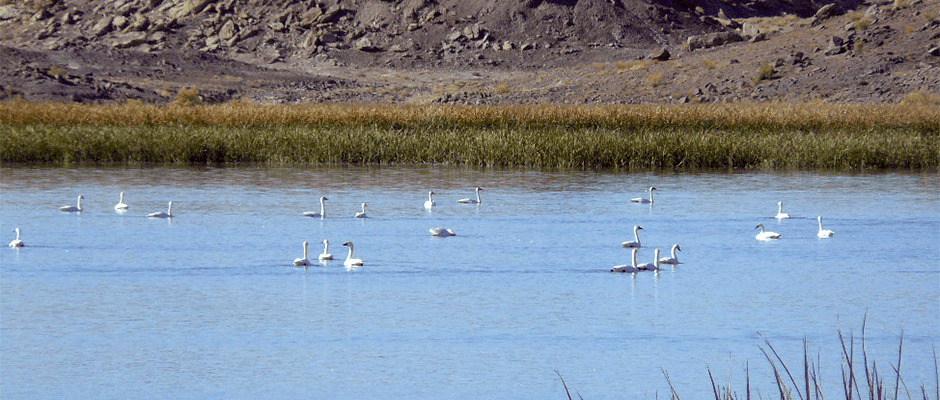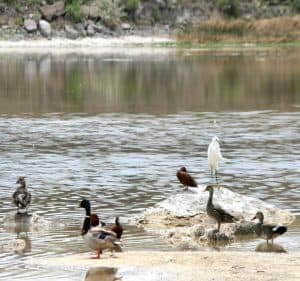Share this article
Utah desert wetlands abundant with migrating birds
As the water in Utah’s Pariette Wetlands evaporates in the June heat, manager Darren Williams wonders what its future holds.
Encompassing 9,204 acres, including 2,529 classified as wetlands or riparian, Pariette is the Bureau of Land Management’s largest wetland development in Utah, but tucked out of the way in the desert, even many locals have never seen this marshy expanse.
“A lot of people born and raised here say they didn’t know it was here,” Williams said.
Pariette Wetlands sits in eastern Utah’s high desert, 50 miles southwest of Vernal. The country is naturally dry, but in the early 1970s, BLM biologists noticed a water impoundment, created by ranchers with permits to graze cattle on the land, had begun to take on the characteristics of natural wetlands.
By 1972, the agency had installed a system of dikes and dams to create 25 ponds from a perennial stream to improve waterfowl production and seasonal habitat for other species. The ponds began attracting an abundance of birds: American white pelicans (Pelecanus erythrorhynchos). White-faced ibis (Plegadis chihi). Herons and egrets. Diving ducks and dabbling ducks. In recent years, wood ducks (Aix sponsa) began appearing.
“Just about every species that is known to occupy the Pacific Flyway hits Pariette,” Williams said.
The wetlands area also provides habitat for elk (Cervus canadensis), mule deer (Odocoileus hemionus), pronghorn (Antilocapra americana), black bears (Ursus americanus) and an abundance of amphibians. Two snake species unknown elsewhere in the region — night snakes (Hypsiglena torquata) and corn snakes (Pantherophis guttatus) — have been spotted. The occasional river otter (Lontra canadensis) appears. Raptors including peregrine falcons (Falco peregrinus) and bald eagles (Haliaeetus leucocephalus) arrive.
The waterways fill with snowmelt each spring, dwindle each summer and replenish in the fall. The birds use the shallow ponds as a place to nest, hatch and fledge on their spring migration northward and as a stopover on the southbound journey in the fall. But each year, agricultural operations and weather patterns leave less and less water available.
For the first time, key sections of the wetlands dried up this year before geese, dabbler ducks and other birds could fledge, Williams said. Until now, the wetlands’ bird populations have remained fairly stable over the years. That will likely begin to change, Williams said. Unless steps are taken to get more water coming to the wetlands, he said, Pariette Wetlands will likely go dry.
”We could lose it.” said Williams, who has been the wetlands’ manager and practically its sole caretaker for the past 10 years, and was its first intern from Utah State University about 20 years ago.
The wetlands’ water rights are secondary to those of the ranchers to the west. That didn’t use to be a problem. The wetlands would fill in the spring from the Uinta Mountains’ melting snowpack. Managers would direct water to create deep ponds for divers, shallow ponds for dabblers and flooded meadows for shorebirds. In February, the first migrating birds would arrive. They would nest and fledge, taking off in the spring just as the marshes were drying and farmers began using water for irrigation. In the fall, when the ranchers stopped needing irrigation and the monsoon rains arrived, the wetlands filled in time for migrating flocks to return.
But in recent years, Williams said, more and more ranchers have been impounding water to ensure enough irrigation water to get through dry summers. That’s left less water for Pariette as a series of dry years with milder monsoon cycles have made it harder refill.
“When I first started managing in 2008, I was able to maintain year-round water in the system,” Williams said. “Starting in about 2012, it started drying up every year.”
Now, he said, the lower water levels could impact bird numbers, which have remained relatively stable, according to census counts dating back to 1980. The dry ponds have begun filling with vegetation, choking out the open water.
“The future of this system is teetering on the ability to keep water coming into that system,” Williams said. Without that, “There is a real possibility of it drying up.”
If the federal government can find a way to keep water in the system, Pariette Wetlands will survive, Williams said. Without it, he worries, the desert oasis will fade and the birds on the Pacific Flyway will have to find nesting grounds elsewhere.
The BLM is working on securing additional water rights that would not be impacted from changing irrigation practices and would aid in keeping this desert oasis viable for future generations.
“It’s an awesome place,” Williams said. “And the wildlife is amazing!”
The Bureau of Land Management is a Premier Partner of The Wildlife Society.
Header Image: Dams and dikes capture snowmelt to turn the desert of eastern Utah into a system of wetlands. ©BLM









